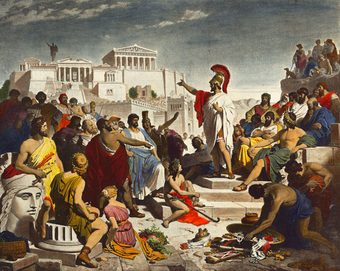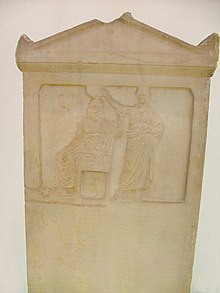

Athenian democracy developed around the 6th century BC in the Greek city-state (known as a polis) of Athens, comprising the city of Athens and the surrounding territory of Attica. Although Athens is the most familiar of the democratic city-states in ancient Greece, it was not the only one, nor was it the first; multiple other city-states adopted similar democratic constitutions before Athens.[1][2] By the late 4th century BC, as many as half of the over one thousand existing Greek cities might have been democracies.[3] Athens practiced a political system of legislation and executive bills. Participation was open to adult, free male citizens (i.e., not a metic, woman or slave.) Adult male citizens probably constituted no more than 30 percent of the total adult population.[4]
Solon (in 594 BC), Cleisthenes (in 508–07 BC), and Ephialtes (in 462 BC) contributed to the development of Athenian democracy.[5] Cleisthenes broke up the unlimited power of the nobility by organizing citizens into ten groups based on where they lived, rather than on their wealth.[5] The longest-lasting democratic leader was Pericles. After his death, Athenian democracy was twice briefly interrupted by oligarchic revolutions in 411 and 404 BC, towards the end of the Peloponnesian War. It was modified somewhat after it was restored under Eucleides; the most detailed accounts of the system are of this fourth-century modification, rather than the Periclean system. Democracy was suppressed by the Macedonians in 322 BC. The Athenian institutions were later revived, but how close they were to the original forms of democracy is debated.
- ^ Robinson, Eric W. (1997). The First Democracies: Early Popular Government Outside Athens. Historia - Einzelschriften. Stuttgart, Germany: Franz Steiner Verlag. ISBN 978-3515069519.
- ^ Robinson, Eric W. (2011). Democracy beyond Athens: Popular Government in the Greek Classical Age. Cambridge, England: Cambridge University Press. ISBN 978-0521843317.
- ^ Josiah Ober, The Rise and Fall of Classical Greece (2015) Princeton University Press, USA.
- ^ Thorley, John (2005). Athenian Democracy. Lancaster Pamphlets in Ancient History. Routledge. p. 74. ISBN 978-1-13-479335-8.
- ^ a b "Ancient Greek civilization - The reforms of Cleisthenes". Encyclopedia Britannica. Retrieved 10 March 2021.